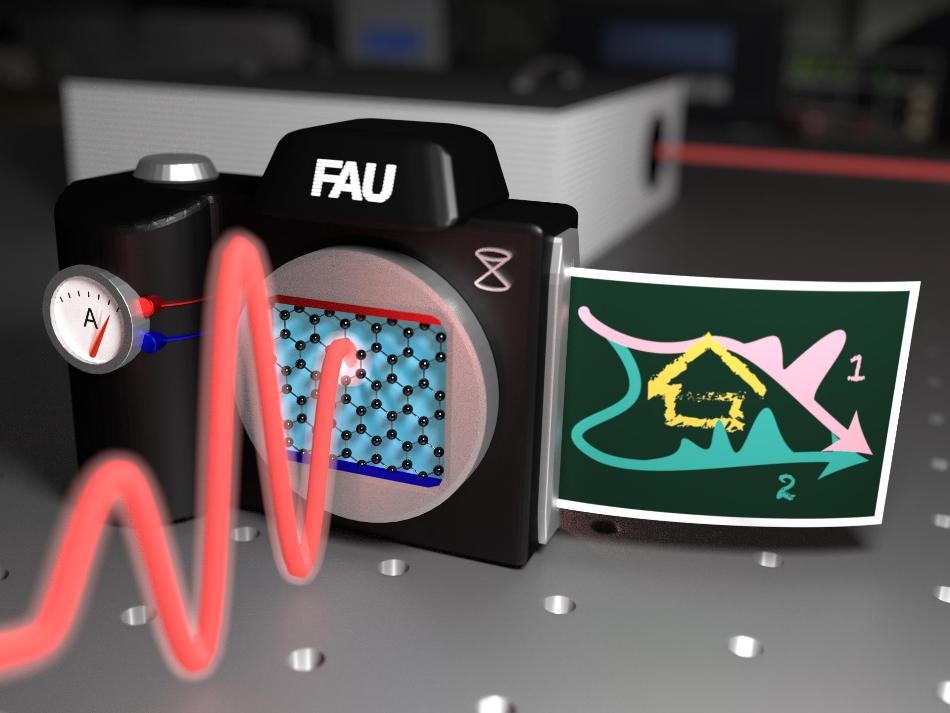Sep 26 2017
It is essential to control electronic current in modern electronics because streams of electrons that transfer signals and data are controlled at high speed. With advances in technology, the need for transmission speeds is also growing.
 Schematic of the experiment for ultra-fast current generation: When the light wave (red) hits the graphene (honeycomb grid), an electronic current is generated instantly. By reading and analyzing this current, FAU researchers have found that quantum mechanical interference of electron waves can be used to control current on extremely short time scales. (Image: FAU / Takuya Higuchi)
Schematic of the experiment for ultra-fast current generation: When the light wave (red) hits the graphene (honeycomb grid), an electronic current is generated instantly. By reading and analyzing this current, FAU researchers have found that quantum mechanical interference of electron waves can be used to control current on extremely short time scales. (Image: FAU / Takuya Higuchi)
Researchers from the Chair of Laser Physics and the Chair of Applied Physics at Friedrich-Alexander-Universität Erlangen-Nürnberg (FAU) have successfully used a single laser pulse within a femtosecond to switch on a current with a preferred direction in graphene. A femtosecond corresponds to the millionth part of a billionth of a second and is over a thousand times faster than the most efficient transistors available today.
Graphene is up to the job
In gases, insulating materials and semiconductors, Scientists have already shown that it is possible to steer electrons with light waves and thus, in principle, to control current. But this concept is yet to be applied to metals because light cannot generally enter the material to control the electrons within it. In order to prevent this effect, Physicists in the working groups of Professor Dr. Heiko Weber and Professor Dr. Peter Hommelhoff used the well-known semimetal, graphene which contains just one layer of carbon atoms. Despite being an excellent conductor, graphene is thin enough to allow some light to enter the material and shift the electrons.
The Scientists performed experiments, where they fired very short laser pulses with uniquely engineered waveforms onto graphene. As soon as these light waves bombard the graphene, the electrons within it were thrown in one direction, like a whiplash.
Under intense optical fields, a current was generated within a fraction of an optical cycle – a half femtosecond. It was surprising that despite these enormous forces, quantum mechanics still plays a key role.
Dr. Takuya Higuchi, the Chair of Laser Physics and the First Author of the publication
Two paths to the same destination
The research team found that complicated quantum mechanics is followed by the current generation process in the graphene. The electrons use two paths instead of one when traveling from their initial state to the excited state – just like a forked road that leads to the same destination. Similar to a wave, the electrons split at the fork and flow on both roads at the same time. Based on the relative phase between the split electron waves, when they meet again, the current can either be extremely large or not present at all.
This is like a water wave. Imagine a wave breaks against a building wall and flows to the left and the right of the building at the same time. At the end of the building, both parts meet again. If the partial waves meet at their peak, a very large wave results and current flows. If one wave is at its peak, the other at its lowest point, the two cancel one another out, and there is no current. We can use the light waves to regulate how the electrons move and how much electricity is generated.
Professor Dr. Peter Hommelhoff, the Chair of Laser Physics
Will we see electronics controlled by light frequency in the future?
The results demonstrate another key step in bringing optics and electronics together. Going forward, the method could pave the way for realizing ultrafast electronics that operate at optical frequencies.
The Researchers have published their results in the journal, Nature, and the study was supported by the European Research Council (Consolidator Grant NearFieldAtto) and SFB 953 ‘Synthetic Carbon Allotropes’.